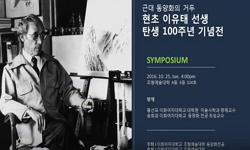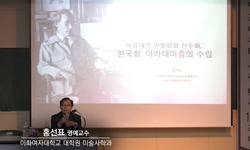The purpose of this study is to reevaluate the relationship between Park Saeng-gwang (1904-1985), a well-known master of Korean painting, and Japanese painting. Park Saenggwang, who received a modern education during the Japanese colonial era, came to...
http://chineseinput.net/에서 pinyin(병음)방식으로 중국어를 변환할 수 있습니다.
변환된 중국어를 복사하여 사용하시면 됩니다.
- 中文 을 입력하시려면 zhongwen을 입력하시고 space를누르시면됩니다.
- 北京 을 입력하시려면 beijing을 입력하시고 space를 누르시면 됩니다.
https://www.riss.kr/link?id=A108926490
- 저자
- 발행기관
- 학술지명
- 권호사항
-
발행연도
2023
-
작성언어
Korean
-
주제어
박생광 ; 동양화 ; 일본화 ; 일본미술원 ; 일한친화회 ; Park Saeng-gwang ; Korean painting ; Japanese painting ; Nihon Bijutsuin ; Japan and Korea Shinwa-kai
-
KDC
910
-
등재정보
KCI등재
-
자료형태
학술저널
-
수록면
5-27(23쪽)
- 제공처
-
0
상세조회 -
0
다운로드
부가정보
다국어 초록 (Multilingual Abstract)
After concluding his second stay in Japan and returning to Korea in 1977, Park Saeng-gwang reached his peak in the 1980s by creating significant works that focused on the ethnic themes such as folk painting motifs and shamans. Previous research on Park Saeng-gwang has primarily concentrated on his representative works from 1977 to 1985. While the state of mind he reached in his later years had an epoch-making significance that made us reconsider the meaning of Korean painting, it is essential to consider what significance his first period in Japan, during his youth, and his second period in Japan in his seventies hold for his ground as a painter. While the first period in Japan was a crucial time for Park Saeng-gwang to establish his position as a painter, his artistic style underwent a significant transformation after his second stay in Japan. To analyze the unique body of work created by Park Saeng-gwang, who absorbed both Japanese and Korean painting, innovating while preserving tradition each of its own, a deeper analysis of his experiences in Japanese painting is thought to be needed.
Research on Park Saeng-gwangs second period in Japan in the 1970s is relatively scarce, but it is believed to be a turning point in his artistic style transformation that followed. Notably, during this time, Park Saeng-gwang contributed articles to the journal ‘Shinwa’ published by ‘Japan and Korea Shinwa-kai’ on nine occasions between 1976 and 1977. While these articles were brief, they provide fascinating insights as he reflected on his life. By tracing his thoughts during his stay in Japan in the 1970s based on the content of these articles, it allows for a reconsideration of what Japanese painting meant to him and his relationship with Japanese painters.
The purpose of this study is to reevaluate the relationship between Park Saeng-gwang (1904-1985), a well-known master of Korean painting, and Japanese painting. Park Saenggwang, who received a modern education during the Japanese colonial era, came to Japan in 1920 to study painting. After his studies in Kyoto, he relocated to Tokyo, where he actively engaged in various avant-garde Japanese art groups pursuing new forms of Japanese painting until 1945. Upon returning to his homeland, Park Saeng-gwang spent around 30 years of unfavorable time in relative obscurity due to the prevailing trend against colored pictures after liberation. However, in 1974, he returned to Japan once again and, for approximately three years until 1977, he was engaged in positive activities such as exhibiting his works in exhibitions held by Nihon Bijutsuin and holding personal exhibitions.
After concluding his second stay in Japan and returning to Korea in 1977, Park Saeng-gwang reached his peak in the 1980s by creating significant works that focused on the ethnic themes such as folk painting motifs and shamans. Previous research on Park Saeng-gwang has primarily concentrated on his representative works from 1977 to 1985. While the state of mind he reached in his later years had an epoch-making significance that made us reconsider the meaning of Korean painting, it is essential to consider what significance his first period in Japan, during his youth, and his second period in Japan in his seventies hold for his ground as a painter. While the first period in Japan was a crucial time for Park Saeng-gwang to establish his position as a painter, his artistic style underwent a significant transformation after his second stay in Japan. To analyze the unique body of work created by Park Saeng-gwang, who absorbed both Japanese and Korean painting, innovating while preserving tradition each of its own, a deeper analysis of his experiences in Japanese painting is thought to be needed.
Research on Park Saeng-gwangs second period in Japan in the 1970s is relatively scarce, but it is believed to be a turning point in his artistic style transformation that followed. Notably, during this time, Park Saeng-gwang contributed articles to the journal ‘Shinwa’ published by ‘Japan and Korea Shinwa-kai’ on nine occasions between 1976 and 1977. While these articles were brief, they provide fascinating insights as he reflected on his life. By tracing his thoughts during his stay in Japan in the 1970s based on the content of these articles, it allows for a reconsideration of what Japanese painting meant to him and his relationship with Japanese painters.
동일학술지(권/호) 다른 논문
-
- 동북아시아문화학회
- ??明(Huang, Yue ming)
- 2023
- KCI등재
-
무라카미 하루키(村上春樹)문학에서의 실존에 관한 일고 - 가와이 하야오(河合隼雄)를 중심으로 -
- 동북아시아문화학회
- 정승운(Jeong, Seung un)
- 2023
- KCI등재
-
Григорий Мелехов и его путь сквозь Гражданскую войну
- 동북아시아문화학회
- Ли КиДжу(Lee, Ki ju)
- 2023
- KCI등재
-
고등학생이 지각한 학업스트레스와 학교생활 부적응 간의 관계에서 긍정심리자본의 매개효과
- 동북아시아문화학회
- 고경희(Koh, Kyung hee)
- 2023
- KCI등재





 DBpia
DBpia



